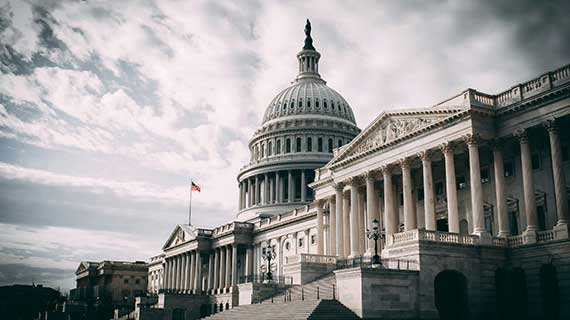Steve's
Vision

Border Security
- Secure The Border: Strengthen efforts to protect our southern border.
- Increase Border Patrol: Provide more resources and support for border patrol agents.
- Support ‘Stay in Mexico’ Policy: Ensure asylum seekers remain in Mexico while their claims are processed.
- End ‘Catch and Release’: Prevent illegal immigrants from being released into U.S. communities without proper legal proceedings.
Policy Proposals
1. Increase funding for border security
- Adjusted for inflation, spending on immigration enforcement has fallen since 2019
- Even the Biden Administration acknowledges that we face a shortage of new border agents
- We should increase spending to hire more border patrol agents, expand detention space, finish building the wall, and invest in technology and infrastructure to better protect the nation’s borders.
Background
Spending on immigration and border enforcement has fallen since Biden took office after accounting for inflation. The inadequate funding has contributed to our current border crisis leading to staffing shortages among border patrol agents. Even Biden Administration officials acknowledge there is a shortage of CBP agents and officials. Given attrition and greater needs, CBP projects they must hire 5,000 new agents and officials over the next five years to reach this administration goals. Meanwhile, recent efforts to expand the number of detention spaces failed in Congress. Increasing budget authority for immigration enforcement is thus key in solving the border crisis.
2. Limit asylum claims for those entering illegally
- Both Presidents Biden and Trump have tried to limit asylum claims by those crossing illegally, but these efforts likely violate current immigration law
- Congress should fix our immigration law to allow DHS to ban asylum claims for those entering unlawfully, particularly when these entries are at high levels
Background
Both Presidents Biden and Trump issued rules limiting asylum claims for persons who attempt to enter the country illegally. These rules have been challenged in court and as shown by the Biden Administration, may be relaxed as politics dictates. Most recently, after border security legislation died in the Senate, President Biden announced a policy that would ban asylum claims by unlawful entrants when illegal crossings exceed 2,500 per day. In 2018, multiple federal courts ruled that a similar order by President Trump violated immigration law. Only Congress can alter immigration laws to ensure the asylum procedure is not abused or exhausted.
3. Enact immigration reform to address these challenges, once and for all
- The only permanent answer to our immigration problem is reform by Congress—not unilateral actions by the White House
- Immigration reform must include an overhaul in the nation’s legal immigration system and address the legal status of those here unlawfully
Background
Over the last twenty years, Congress has tried to enact comprehensive immigration reform that address a range of related issues from border security and legal status of persons residing in the U.S. unlawfully. When these efforts have failed, Presidents have issued legally suspect orders (e.g., DACA, President Biden’s recent EO). The result is a chaotic immigration system that leaves our borders unsecure and has resulted in a tragic humanitarian crisis at the border and in cities across the nation.

Cost of Living
- Fight Rising Costs: Out-of-control spending has increased the cost of living by $8,000 a year for families of four, making homeownership and car financing more difficult.
- Streamline Regulations: Over $600 billion in new federal regulations in the past three years—let’s cut through the red tape to make it easier to start and grow businesses.
- Address Soaring Costs: Food, energy, and interest rates are at record highs, straining California families.
- Cut Regulations, End Mandates: Emphasize free market solutions, control spending, and reduce unnecessary mandates that drive up costs.
Policy Proposals
1. Control federal spending
- The 40-year high in inflation was a direct consequence of out-of-control government spending
- The spending spree was a bipartisan undertaking by career politicians who enacted over $5 trillion in new spending in 2020 and 2021
- Maintaining low inflation requires getting the federal budget under control
Background
The large spending during the COVID pandemic and subsequent response by the Federal Reserve produced the 40-year higher inflation. Even President Obama’s former Treasury Secretary Larry Summers warned that President Biden’s American Rescue Plan Act of 2021 (ARPA) would lead to large increases in the inflation rate. Importantly, ARPA was preceded by several additional spending packages during the Trump Administration including the March 2020 CARES Act and the December 2020 omnibus spending bill. Combined, the Biden and Trump Administration enacted over $5 trillion in new spending during the COVID-19 pandemic.
2. Codify regulatory budgets into law
- President Trump’s regulatory budgets reduced the regulatory burden on businesses and families by over $160 billion dollars.
- Regulatory budgets should be codified in law so all administrations must limit the burden their regulations have on the economy
Background
As part of the Trump Administration’s regulatory reform efforts, federal agencies were strictly limited in the amount of regulatory costs they could impose on Americans. These “regulatory budgets” put annual cost caps on agency regulation, requiring regulators to account for the total cost of their regulations and encouraging agencies to find obsolete, burdensome regulations that could be eliminated. The budgets proved successful in reducing regulatory burdens, cutting regulatory costs by as much as $160 billion. Despite their success, President Biden rescinded these rules shortly after entering office. To permanently restrain regulators, Congress must codify regulatory budgets into law.
3. Stop policymakers from implementing costly regulations
- We must stop enacting laws that create new costs and regulatory burdens for families and businesses
- Congress should use the Congressional Review Act to exercise appropriate oversight over regulators when they issue burdensome rules
- We should confirm judges that will not allow bureaucrats do expand their regulatory authority beyond the limits that Congress has specified
Background
Since 2021, the Biden Administration has finalized over 1,000 new regulations with a total long-term cost to the economy of $1.7 trillion. These costs include $870 billion in projected costs associated with President Biden vehicle emission standards. Encouragingly, the Supreme Court recently ruled (the Loper Decision) that judges should not defer to a regulator’s interpretation of ambiguous statues (so-called Chevron Deference). Congress can exercise power over regulators through enacting narrowly constructed laws that limit agencies powers to implement costly rules. They can exercise Congressional oversight through the Congressional Review Act.
4. Hold the Federal Reserve accountable
- Federal Reserve independence is important to maintaining low inflation
- But the Fed failed Americans when it underwrote the Federal Government’s massive spending spree
- To avoid a cycle of inflation, the Federal Reserve must make clear to markets that it will maintain its two percent inflation target and commit itself to reducing its balance sheet
Background
During the COVID-19 crisis, the Federal Reserve was slow to respond to rising inflation rates. Fed authorities claimed that the price increases were the consequence of supply shocks and would only be “transitory.” In 2021, the Federal Reserve even issued a policy change suggesting it would aim for inflation rates above its historic two percent target. The Fed’s delay led to more inflationary pressures, leading to even higher interest rates and more economic harm. Today, the Federal Reserve still maintains a balance sheet of more than $7 trillion—nearly 10 times what it held prior to the 2008 recession.

Homelessness
- Unacceptable and Growing Problem: Homelessness is increasing by 15% each year, with California accounting for 30% of the nation’s homeless population.
- Audit Spending: California spends over $7 billion annually—$42,000 per homeless person. It’s time to audit where this money is going.
- Engage Private Industry: Partner with private organizations like the Alpha Project to develop innovative, effective solutions.
- Address Root Causes: Acknowledge mental health issues and addiction as major contributors to homelessness.
- Support New Federal Solutions: Push for federal programs that bring fresh, effective approaches to this growing crisis.
Policy Proposals
1. End “housing first” requirements
- Policy makers in Washington and Sacramento are insisting on this one-size-fits-all approach
- Housing first policies help some chronically homeless, but many people are left behind
- We should not stand in the way of faith-based and other community organizations that have success in helping the homeless through alternative approaches
Background
For the last decade, federal and state policy makers have insisted that homelessness programs embrace a “housing first” approach. This approach provides access to housing without conditioning support on sobriety or participation in treatment programs. In 2016, California lawmakers enacted SB1380 that required state funding for homelessness programs go only to programs that have housing first policies. SB1380 and related federal policies have reduced funding for alternative programs—including many faith based—that offer a more holistic approach to the problem of homelessness.
2. Confirm judges that won’t legislate from the bench
- Unelected judges handcuffed local government’s ability to ensure public safety
- In the words of Gavin Newsom: “[the Ninth Circuit’s decision] tied the hands of local officials for years and limited their ability to deliver on common-sense measures to protect the safety and well-being of our communities.”
- We should nominate and confirm judges understand that their job is not to act as legislator
Background
Over the last several years, the Ninth Circuit Court of Appeals had ruled multiple times that cities and municipalities could not enforce camping and sleeping bans. The court ruled that the bans effectively criminalized being homeless. They ruled that it was unconstitutional to enforce the bans unless a municipality had sufficient housing to accommodate its entire homeless population, regardless of whether there actually available beds. In City of Grants Pass v. Johnson, the Supreme Court overruled the Ninth Circuit. As Justice Gorsuch argues in the decision: “A handful of federal judges cannot begin to “match” the collective wisdom the American people possess in deciding ‘how best to handle’ a pressing social question like homelessness.”
3. Enforce the laws
- The goal isn’t to imprison people but allowing people to remain homeless and drug-addicted isn’t compassionate
- Efforts to limit the enforcement of drug laws have hurt the most vulnerable
Background
California lawmakers and voters have enacted several criminal justice reforms intending to reduce the state’s incarcerated population. While these efforts had good intentions, they have likely exacerbated the homelessness problem. For example, in 2014, voters enacted proposition 47 in 2014 which reclassified many drug offenses and thefts from felonies to misdemeanors. Subsequent research has shown that individuals that benefit from the proposition were less likely to enter or remain in drug treatment programs.

Criminal Justice
- Fix the Failures of Prop 47 with Prop 36: Prop 47 has led to a surge in crime by reducing penalties for serious offenses. Supporting Prop 36 helps correct these failures by ensuring that repeat and violent offenders face the justice they deserve, while stopping the revolving door for criminals who exploit weak sentencing laws.
- Back the Blue: Ensure law enforcement has the training, equipment, and education needed to protect our communities.
- Enforce the Law: Hold prosecutors accountable and ensure existing laws are enforced—no more looking the other way.
- Support Stiffer Penalties: Advocate for tougher penalties to deter crime and keep our streets safe.
- Fund, Don’t Defund the Police: Defunding is not the answer—better funding for training and resources is essential.
- Blind Justice: The justice system must be equal and blind, without political influence—reforms may be necessary to ensure fairness.
Policy Proposals
1. Support Proposition 36
- Since the passage of Proposition 47, crime has risen in California
- Far from being humane, Proposition 47 has made it more difficult for those with substance abuse problems to enter treatment
- Proposition 36 would renew California’s commitment to safe streets while providing more opportunities to help those with substance abuse problems.
Background
Proposition 47 relaxed criminal charges, reclassifying several felonies for drug possession and thefts as misdemeanors. The result has been declining arrest rates and rising crime rates. Proposition 36 would begin to undo the harmful effects of Proposition 46 and other decriminalization efforts by state and local policy makers. If passed in November, Proposition 36 would reclassify certain misdemeanors as felonies. Among other provisions, theft for goods under $950 would be charged as felony if the offender has already been convicted of property theft two or more times. Certain drug possession cases would be charged as “treatment-mandated felonies” for repeat offenders. Those convicted of a treatment-mandated felony would face up to three years in state prison, but they could have their charges dismissed if they complete a treatment program.
2. Increase funding for hiring new police offers
- The US faces a shortage of police officers, endangering the safety of nation’s most vulnerable
- Policing remains primarily the responsibility of state and local government, but the federal government can help by providing federal grants to increase the number of new police hires
Background
While the federal government has a limited role in local law enforcement, it does provide funding for some community policing. In particular, the Community Oriented Policing Services (COPS) program is a Department of Justice initiative that provides grants to state and local governments to support community policing. The money goes to hiring, training, and developing new policies strategies. In the last few years, Congress has more than doubled funding for the program. In FY2024, total budget authority for COPS was $685 million, up from $208 million in 2015. Most of the new funds, however, were directed at non-hiring initiatives (e.g., antiheroin task forces, active shooter training). Budget authority for hiring new offices has risen far less—from $135 million in 2015 to $157 million in 2024.
3. Surge federal resources to address violent crime
- Criminals have been emboldened by “reform” prosecutors who explicitly refuse to enforce certain laws, resulting in a tragic increase in crime rates in the nation’s largest cities
- We should surge federal law enforcement resources to communities facing waves of violent crime rates, particularly in places where local prosecutors refuse to enforce the laws
Background
The failure of local prosecutors to enforce laws produced a spike in crime in many of the nation’s largest cities. While the federal role in local policing is inherently limited, the Department of Justice has recently surged federal law enforcement resources to cities with particularly high violent crime rates. DOJ’s Criminal Division’s Violent Crime Initiative (VCI) has been launched in Houston, Memphis, St. Louis, Jackson, and Hartford. In 2021, Senator Cotton proposed surging federal prosecutors to proposed to cities that had rogue DAs who were refusing to prosecute certain crimes (e.g., San Francisco, Los Angeles).

Energy Policy
- Energy as a Vital Commodity: Energy is essential for consumers, businesses, and national security. It must be affordable, environmentally compatible, and dependable.
- Free Market Solutions: Support free market-driven approaches to energy production rather than burdensome government mandates.
- Careful Transition to Renewables: Ensure a transparent, gradual transition to renewable energy sources that protects jobs and the economy.
Policy Proposals
1. Overhaul Energy Regulations
- Congress should streamline federal permitting process for energy projects to ensure regulators cannot stymie new energy projects.
- Congress should codify Trump-era rules that prevent bureaucrats from abusing environmental regulations to stop vital energy and infrastructure projects
Background
Our nation’s environmental protections should be designed to ensure future generations inherit a cleaner America. Today, however, environmental regulations are being used by Washington elites to reshape the economy regardless of voters’ wishes or the original intention of our environmental laws. Regulators have expanded the National Environmental Policy Act (NEPA), the Clean Air Act, the Clean Water Act, and the Endangered Species Act. The result has been higher energy prices. For many in Washington, these rising prices are not an unfortunate side effect—they are the goal.
2. Fix Inflation Reduction Act’s flawed energy tax credits
- The Inflation Reduction Act’s energy tax credits were a giveaway to corporations and interest groups that donated heavily to President Biden
- These tax credits were projected to cost $369 billion over 10 years, but they are now projected to cost between $515 billion and $1.2 trillion
- Congress should reform the tax credits to cap the expense for new projects
Background
The Inflation Reduction Act (IRA) provided tax credits for various clean energy and related projects. At the time of the law’s passage, the tax credits were projected to cost $369 billion over 10 years, but high take-up rates have increased the cost projections to between $515 billion and $1.2 trillion. While outright repealing the tax credits would lead to economic damages for those who have already relied on them for investment, Congress should reform IRA to prevent further excesses.
3. Increase leases for drilling on federal lands
- The Biden Administration and prior democratic administrations have repeatedly stopped oil and natural gas exploration on federal lands
- Expanding opportunities for new leases will mean lower prices in the future
Background
In January 2021, President Biden signed an executive order that paused new oil and natural gas leasing on federal land. A federal judge issued an injunction against the pause in June 2021, but the administration’s actions and subsequent court challenges resulted in the Biden Administration not holding any new lease sales until late June 2022. The Biden Administration points to an increase in drilling permits on federal land in 2021 as evidence that it has sought to increase domestic energy production. Further, they argue the pause would not have materially affected today’s energy prices as development takes years. GOP lawmakers, however, have noted that administration’s lease pauses will reduce long-term domestic energy production.

Water Policy
- Secure Water Supply: Prioritize infrastructure projects to improve water storage, delivery, and recycling, ensuring California has a reliable water supply even during droughts.
- Protect Agriculture: California’s farms feed the nation. Invest in technologies and policies that support water efficiency and availability for farmers and ranchers.
- Balance Conservation and Growth: Encourage responsible water use while supporting policies that allow California’s communities and industries to grow sustainably.
- Oppose Overregulation: Work to eliminate excessive regulations that restrict water access and innovation, allowing for more flexible, market-based water management solutions.
- Innovate for the Future: Promote research and development in desalination, groundwater replenishment, and other advanced water technologies to address long-term water security.
Policy Proposals
1. Enact permitting reform
- Ensuring California families and farmers have affordable access to water requires expanding and rebuilding the state’s water infrastructure
- California lawmakers have failed for 50 years to build a major new reservoir, and they are only now trying to expand capacity
- New efforts to build new reservoirs and water ways are being slowed by a cumbersome federal permitting process that must be overhauled
Background
The Federal Government requires a complicated environmental permitting process for major infrastructure projects including new water reservoirs and aqueducts. One promising legislation that will achieve many of these goals is the Simplify Timelines and Assure Regulatory Transparency (START) Act, which was introduced by West Virginia Senator Shelley Moore Capito and co-sponsored by 46 Republican Senators. The Act would have expedited the permitting and review process by setting strict time limits on agency review periods.
2. Remove Biden regulations and regulatory uncertainty
- Even after the Supreme Court limited the EPA’s authority, the Biden Administration continues to overstep its statutory authority to regulate bodies of water
- The result is that farmers face significant uncertainty over whether they are subject to burdensome rules
Background
The Clean Water Act gives the EPA authority to regulate water pollution and water quality on “waters of the United States” (WOTUS) In 2015, the Obama Administration expanded the definition of WOTUS to include many temporary bodies of water and other wetlands that are not normally attached to navigable waters. Farmers objected that the broader definition and the associated threat of greater EPA regulations would increase costs and threaten their access to certain water sources. The Trump Administration issued new rules narrowing the definition, but President Biden reinstituted the earlier rules shortly after entering office. The Supreme Court overruled Biden’s rule in 2023 finding that the definition of WOTUS was limited to “‘streams, oceans, rivers, and lakes’” and to adjacent wetlands that are “indistinguishable” from those bodies of water due to a continuous surface connection.” Despite SCOTUS ruling, the Biden Administration continues to seek ways to heavily regulate more water sources.

K-12 Education
- Focus on Fundamentals: Ensure schools are teaching the basics—math, reading, science, and critical thinking—so students are ready for any path they choose.
- Maximize Education Funding: Ensure state and federal education dollars are directed to classrooms, not lost in bureaucratic overhead.
- Support School Choice: Public schools work well for many, but parents need options when a different approach suits their child’s needs better.
- Engage Parents and Teachers: Strong schools come from involved parents, dedicated teachers, and motivated students, working together to drive educational success.
Policy Proposals
1. Expand School Choice using the federal tax code
- States have taken the leadership role in expanding educational choice
- The federal government can help spur these efforts with targeted legislation that offers tax credits for charitable donations that funds scholarships for K-12 education
Background
All students deserve the best education, not just those with means. Unfortunately, our current system traps many low-income students in failing schools. While universal school choice is likely not political feasible, there are more marginal options that would expand opportunities for these students. For example, Senator Cassidy’s Education Choice for Children Act would provide $10 billion in annual tax credits for donations to non-profit organizations that provide scholarships for K-12 education.
2. Eliminate Biden-era limits on charter schools
- The federal government has offered support for charter schools since 1994, but the Biden Administration has cut the schools’ funding and increased regulations
- Restoring and expanding funding for charter schools is key to delivering education opportunities to students in failing schools
Background
Charter schools have been instrumental in offering educational alternatives for students in failing schools. First created in 1994, the Federal Chart School Program provides federal funding to state and local governments to fund charter schools. During the 2020 presidential campaign, President Biden advocated for ending federal funding for for-profit private charter schools. In 2022, the Biden Administration issued new stringent eligibility rules for federal funding of charter schools. The National Alliance for Public Charter Schools argues that these new rules will prevent thousands of students from entering chart schools. The Biden Administration has subsequently proposed “historic cuts” to the Federal Charter School Program.
3. Extend current tax rules for 529 accounts for K-12 education
- The TCJA allowed parents to withdrawal up to $10,000 a year from 529 accounts for K-12 educational expenses
- Policymakers should make the 529 rule permanent
Background
The 2017 Tax Cuts and Jobs Act (TCJA) allowed parents to make up to $10,000 in qualified withdrawals for K-12 schooling expenses. This provision will expire in 2026, leaving parents with one fewer way to escape failing public schools.

Higher Education
- Control Costs: Work to reduce the skyrocketing costs of higher education, ensuring affordability for students and their families without compromising quality.
- Promote Career-Focused Education: Encourage universities and community colleges to prioritize degrees and programs that lead directly to good-paying jobs in growing industries.
- Expand Access to Trades and Apprenticeships: Not every student needs a four-year degree. Support vocational training, apprenticeships, and partnerships with industry to prepare students for high-demand fields.
- Hold Institutions Accountable: Ensure that colleges and universities are transparent about outcomes, including graduation rates and job placement, so students and families can make informed decisions.
- Reduce Student Debt: Advocate for practical solutions to alleviate the student debt burden, including exploring income-based repayment options and financial literacy education.
Policy Proposals
1. Expand Pell Grant eligibility for short-term post-secondary education
- Existing subsidies for higher education heavily favor traditional universities and colleges, which are ill-suited for many workers looking to develop new skills
- Expanding Pell Grants to pay for short-term skills-based training would provide access to more low-skilled workers
Background
Pell Grants provide post-secondary education subsidies to individuals who meet certain income requirements. Initially, the subsidies were available only to individuals earning college degrees. They were expanded to cover specific vocational programs that consist of at least 15 weeks of schooling. Over the last few years, there have been several legislative proposals to provide Pell Grants for short-term skills-based trainings. The JOBS Act, for example, would provide subsidies to students enrolled in job training programs providing at least eight weeks of instruction.
2. Expand the federal apprenticeship program
- Traditional higher education is not the only path to rewarding careers; many new workers would be better served by apprenticeships and other on-the-job training programs
- The Trump Administration expanded the federal apprenticeship program to cover more trades, but these expansions were repealed by the Biden Administration
- Congress should enact legislation that would permanently expand these efforts, particularly in fields with high demand
Background
The Registered Apprenticeship system is an 80-year-old program that regulates and subsidizes approved apprenticeship programs. Critics argue that the programs are narrowly concentrated in legacy industries who have developed close relationships with Washington elites. The American Action Forum found that 90 percent of registered apprenticeship programs were related to five industries: construction, public administration, manufacturing, transportation, and utilities. Meanwhile, less than four percent of apprenticeships were for health care or service-oriented jobs, even though these industries account for a large share of future job growth. To remedy this shortcoming, the Trump Administration created Industry-Recognized Apprenticeship Programs (IRAPs), which provided federal support for additional apprenticeship programs for high-growth industries that have largely been excluded from existing apprenticeship programs. Over 130 IRAPS were created, mainly for nursing credentials. Shortly after entering office, President Biden prohibited the recognition of new IRAPs. Members of Congress have subsequently tried to make IRAPs permanent with proposed legislation including the Training America’s Workforce Act.

Budget
- Fiscal Responsibility: Ensure federal spending is controlled and targeted, focusing on what truly benefits the American people.
- Eliminate Wasteful Spending: Cut unnecessary government programs and eliminate inefficiencies that lead to overspending.
- Balanced Budgets: Push for balanced budgets that prioritize key investments while reducing the national debt for future generations.
- Invest Wisely: Focus spending on critical areas like infrastructure, national security, and education—while eliminating reckless expenditures.
- Rein in Government Growth: Ensure that government growth is kept in check, supporting a leaner, more effective federal system.
Policy Proposals
1. Restrain non-defense discretionary spending by returning to pre-pandemic baseline
- Since 2019, spending on non-defense programs have increased by more than 20 percent after accounting for inflation
- Returning non-defense discretionary spending to its January 2020 baseline projections would save taxpayers over $1.3 trillion.
Background
Non-defense discretionary spending has exploded since 2019. In that year, the federal government spent $660 billion on non-defense discretionary programs. In 2023, this spending had risen to $911 billion. After accounting for inflation, non-defense discretionary spending has risen by more than 20 percent. Returning discretionary spending to its January 2020 Congressional Budget Office (CBO) baseline would restore a semblance of normalcy to the federal budget. Over the next 10 years, that change alone would reduce non-interest deficits by $1.3 trillion.
2. Enact real budgets—on time
- Congress has failed to enact budgets on time for over 20 years
- Repeated continuing resolutions and massive omnibus measures lead to bad fiscal policy
- Congress must return to a normal appropriations process with on-time budgets
Background
The annual appropriations process provides funding for discretionary spending for the next fiscal year. Congress can pass regular appropriations acts for a particular discretionary spending category or enact “Omnibus” bills that cover multiple categories of spending. The deadline for this process is October 1, but recent Congresses have failed to enact full budgets by October 1 and were forced to enact multiple Continuing Resolutions (CRs). CRs reduce government efficiency and potentially raise costs, particularly for defense operations and acquisitions.
3. Reform compensation for federal workers
- Civilian workers for the government receive benefit packages that are far more generous than those offered in the private sector
- Restraining fringe benefits by increasing retirement contribution requirements and capping the government’s share of health benefits would save taxpayers $80 billion over the next decade
Background
There were more than 2.2 million federal civilian workers in FY2022. After accounting for generous fringe benefits, CBO estimates that typical federal civilian workers earn more than their private sector counterparts. Federal civilian benefits are particularly generous. CBO estimated that between 2011 and 2015, the typical federal worker’s benefit package was almost 50 percent higher than those in the private sector. Private sector workers contribute more to their employer-sponsored health plans and have far less generous retirement benefits. Reforming federal employees’ compensation packages would thus save taxpayers billions of dollars, while bringing federal workers’ total compensation more in line with other Americans. These reforms should include increasing and standardizing required retirement contributions and capping federal contributions to civilian employee health care plans. Combined the reforms would save $80 billion over the next decade.

Taxes
- Middle-Class Tax Relief: Support tax cuts for middle-class families to help alleviate the financial burden and boost the economy.
- Simplify the Tax Code: Streamline and simplify the tax code to make it easier for families and businesses to understand and comply, reducing costly loopholes.
- Encourage Small Business Growth: Provide tax incentives for small businesses to invest, expand, and create jobs in local communities.
- Promote Fairness: Ensure that taxes are fair, with everyone paying their fair share while protecting middle- and working-class families from undue burden.
- Limit Government Overreach: Oppose tax hikes that fund unnecessary government growth, and focus instead on creating a more efficient, responsible federal budget.
Policy Proposals
1. Fix federal spending
- We have a spending problem in Washington, not a tax problem
- Since the 2017 tax law was enacted federal tax revenue has risen by 11 percent after adjusting for inflation, but spending has grown more than twice as fast
- Maintaining low taxes on middle-class families will require slowing the growth in federal spending
Background
Many critics of the 2017 tax reform law claim it is responsible for growing federal deficits. Since the tax law was enacted, however, revenue collections rose by 11 percent (from 2017 to 2023) with corporate tax revenue rising fastest (OMB Historical Tables). The budget problems then are not a consequence of tax cuts, but rather large increases in federal spending. Since 2017, spending has risen 28 percent after adjusting for inflation.
2. Stop tax hikes on Californians
- Failing to extend major provisions of the 2017 tax cuts will raises taxes on Californians by an average of $3,600
- The tax increases will affect low-income and middle-income families who have benefited from the expanded standard deduction and increased child tax credits
Background
The Tax Foundation estimates that Californians will pay an average $3,600 more in taxes if they the 2017 Tax Cuts and Jobs Act expires. Every county in California will see an average tax increase. The tax increases will be broad based: A married family with 2 kids earning $85,000 per year will see their taxes rise by $1,660, while a single individual earning $75,000 will see her taxes rise by $1,700.

Housing
- Combat Rising Costs: The cost of building a home has increased by over 30% since Biden took office, driven by inflation and costly regulations.
- Lower Mortgage Rates: Mortgage rates have soared from 2% to 7%, doubling the cost of monthly payments for families.
- Reduce Regulatory Burden: Federal, state, and local regulations make up nearly 20% of the cost of a home. A moratorium on new regulations—other than for safety—is needed to streamline the building process.
- Oppose HUD’s Costly Standards: New HUD energy standards will add about $7,000 to the cost of a new home. We need common-sense solutions that don’t drive prices up.
- Lower Inflation & Interest Rates: Advocate for more disciplined government spending to reduce inflation and bring down interest rates.
- Incentivize Affordable Housing: Provide tax benefits to builders who focus on producing entry-level homes for first-time buyers.
- Encourage Local Zoning Flexibility: Offer incentives to communities (without mandates) to adjust zoning restrictions that make it difficult to build affordable housing.
Policy Proposals
1. Low-Income Housing Tax Credit
- The solution to rising housing costs is clear: increase the supply.
- The federal low-income tax credit encourages developers to expand the supply of housing for low-income families
- The Trump Administration temporary expanded the credit in 2018, but these expansions sunset in 2021
- Congress should permanently expand the credit
Background
The solution to rising housing costs is clear: increase the supply. State governments must take a leadership in ensuring state and local rules do not unnecessarily prevent new development, but the federal government can help too. The Low-Income Housing Tax Credit provides non-refundable tax credits to developers that build new housing or renovate existing housing for low-income Americans. Credits are given to state governments, who then award them to qualified developments. In 2018, Congress expanded the tax credit by 12.5 percent for the tax years 2018 to 2021. Congress should renew this expansion and make it permanent. This reform was recently included in the House’s tax bill package, but the tax bill died in the Senate.
2. Remove burdensome energy requirements
- Existing regulations add thousands of dollars to the cost of new home construction
- The Biden Administration has enacted new rules that could add up to $31,000 to the cost of new homes
- These rules should be repealed by the Administration or through Congressional action
Background
The Biden Administration recently enacted new regulations requiring all new home construction financed by HUD or USDA to conform to expensive energy efficiency regulations. These rules may add up $31,000 to the cost of a new home.
3. Restrain the Federal Budget and Hold the Fed Accountable
- Rising interest have made housing less affordable for all Americans, particular new home buys.
- Keeping interest rates low requires reduce federal deficits by cutting wasteful spending and demanding the Fed focus on keeping inflation low
Background

Health Care
- Lower Health Care Costs: Work to reduce the cost of health care by increasing competition, cutting bureaucracy, and promoting transparency in pricing.
- Expand Access to Care: Ensure that all Americans have access to affordable, quality health care, including rural and underserved communities.
- Preserve Choice: Protect the right of individuals and families to choose the health care plan and providers that work best for them, including private insurance options.
- Promote Innovation: Encourage the development of new treatments and technologies by reducing regulatory barriers and incentivizing research in areas like telemedicine and personalized medicine.
- Address Mental Health and Addiction: Prioritize mental health services and addiction treatment as key components of a comprehensive health care system.
- Medicare and Medicaid Reform: Reform Medicare and Medicaid to ensure long-term sustainability while protecting benefits for seniors and low-income Americans.
- Oppose One-Size-Fits-All Government Programs: Stand against proposals like Medicare for All that eliminate choice and put the government in control of health care decisions.
Policy Proposals
1. Give patients more control
- Government regulations reduce choice in America’s health care system and lower quality
- This is particularly true for Americans who are stuck with Obamacare’s increasingly limited plan options
- Increase choice and lower costs in the individual market by removing burdensome regulations that limit plan options
- Remove burdensome rules that prevent American from taking advantage of HSAs
Background
For the last half century, the government have taken a larger role in health care. Including tax subsidies, well over half of all health spending is now financed by the federal government. The increased spending has led to increased regulations for getting medical care. The result is higher costs and fewer options. In particular, low-income Americans are stuck with low-quality Medicaid programs or increasingly limited Obamacare plan options. Meanwhile, many Americans are unable to take advantage of health savings accounts (HSAs) because of burdensome eligibility requirements. We should expand choice by removing unnecessary restrictions on purchasing health care, such as allowing Americans to buy low-cost catastrophic plans on the Obamacare exchanges and removing eligibility restrictions that prevent HSA take-up.
2. Protect Choice in Medicare
- Career politicians are refusing to act as Medicare approaches bankruptcy
- Democrats are attacking the most popular form of Medicare coverage, Medicare Advantage
- We must preserve Medicare for future generations while delivering more choices to current recipients through fixing and expanding Medicare Advantage options
Background
Medicare now costs taxpayers over $900 billion each year. And within 10 years, the Hospital Insurance Trust Fund will be depleted, at the point Medicare will not be able to fully reimburse hospitals for treating Medicare recipients. Finding ways to fix Medicare while preserving choice and quality should be a top priority for politicians. But the left is focused on regulating prices in Medicare while doing little to improve the quality of the program for recipients. In fact, they are attacking the most popular Medicare option, Medicare Advantage (MA). MA plans are private plans that offer enrollees insurance coverage for both hospital and physician services (and often prescription drugs). MA plans have proved popular among seniors because they often come with lower costs and more benefits than traditional Medicare. The left, however, has long opposed MA. While Medicare in general needs reforms to slow its rising costs, targeting MA is not the answer and will only result in fewer options for seniors.

National Security
- Maintain Military Superiority: Ensure our military remains the most powerful in the world by focusing on readiness, training, and advanced equipment.
- Smart Defense Spending: With a defense budget nearing $900 billion, I will work to ensure that funds are spent efficiently and effectively, maximizing value and eliminating waste.
- Support for Technological Innovation: Prioritize investment in cutting-edge technologies to maintain our military advantage in the face of emerging threats, such as the use of low-cost drones against high-value assets.
- Robust Foreign Policy: Advocate for a strong foreign policy that projects firmness, not weakness, and protects America’s interests abroad.
- Adapt to New Threats: Ensure our defense strategy evolves to meet modern threats, focusing on cybersecurity, space defense, and new forms of warfare.
- Responsible Defense Funding: While the current defense budget is substantial, I will consider additional funding if it is justified and properly allocated by the Department of Defense.
Policy Proposals
1. Increase defense spending
- The world is an increasingly dangerous place
- Effective deterrence requires a robust defense budget
- Despite recent increases, defense spending remains near historic lows
- That money must be spent wisely, requiring an overhaul the Pentagon’s budgeting system and more focus on its annual audits
Background
In the last decade—while the rest of the federal budget was exploding—lawmakers were failing to adequately fund the military. Adjusted for inflation, defense spending in 2021 was lower than in 2011. This decade of defense austerity coincided with a period when other nations—from China to Russia—were expanding their militaries’ capabilities. Adequate funding for our armed forces is needed to ensure the nation is capable of meeting future geopolitical challenges. While House Republicans have worked hard to raise defense spending in the last three budgets, defense spending as a share of economy and as a share of the federal budget remains near historical lows. A far greater investment is needed to promote global stability and deter bad actors. The additional money, however, must be spent wisely. The Trump Administration launched the first successful audit of the pentagon’s entire budget, but little progress has been made on improving the Pentagon’s accounting and information systems.
2. Make long-term investment in nation’s defense capabilities
- Decades of underinvestment and overuse have reduced the nation’s military capabilities
- The U.S. needs to reinvest its naval fleet, modernize its nuclear force, and expand domestic manufacturing of munitions and other arms
- These efforts should be paired with reforms to the Pentagon’s procurement process
Background
President Trump’s 2018 National Defense Strategy recognized the need for significant reinvestment in the nation’s defense capabilities. This included growing the navy’s fleet and modernizing our nuclear forces. Today, the US navy’s active ship force remains below 300—40 percent small than the at the end of the Cold War. More recently, U.S. efforts to supply Ukraine with needed weapons and munitions has led to shortages. Any new investment should be paired with reforms to the Pentagon’s procurement process. Developed in the 1960s, the procurement system ill-suited for the needs of a 21st century fighting force.
3. Strengthen U.S. cybersecurity
- Cybersecurity vulnerabilities threaten the nation’s national security and its economy
- The U.S. must invest more in its cybersecurity systems and build stronger relationships with states and private sector companies
- We must reform an overly bureaucratic and cumbersome hiring process that makes it difficult for the government to hire and retain cybersecurity experts
Background
The nation remains vulnerable to cybersecurity attacks from belligerent nations and non-state actors. Congress has appropriated billions of dollars for cybersecurity, but a cumbersome bureaucracy means much of it is going to waste. We need to give greater flexibility to agencies in hiring cybersecurity experts, including in setting pay and offering opportunities for cybersecurity experts to enter federal service midcareer. In addition, while Congress has earmarked billions for cybersecurity efforts for state and local governments, the federal government has underinvested in relationships with private sector companies that own and operate most of the nation’s critical infrastructure.

